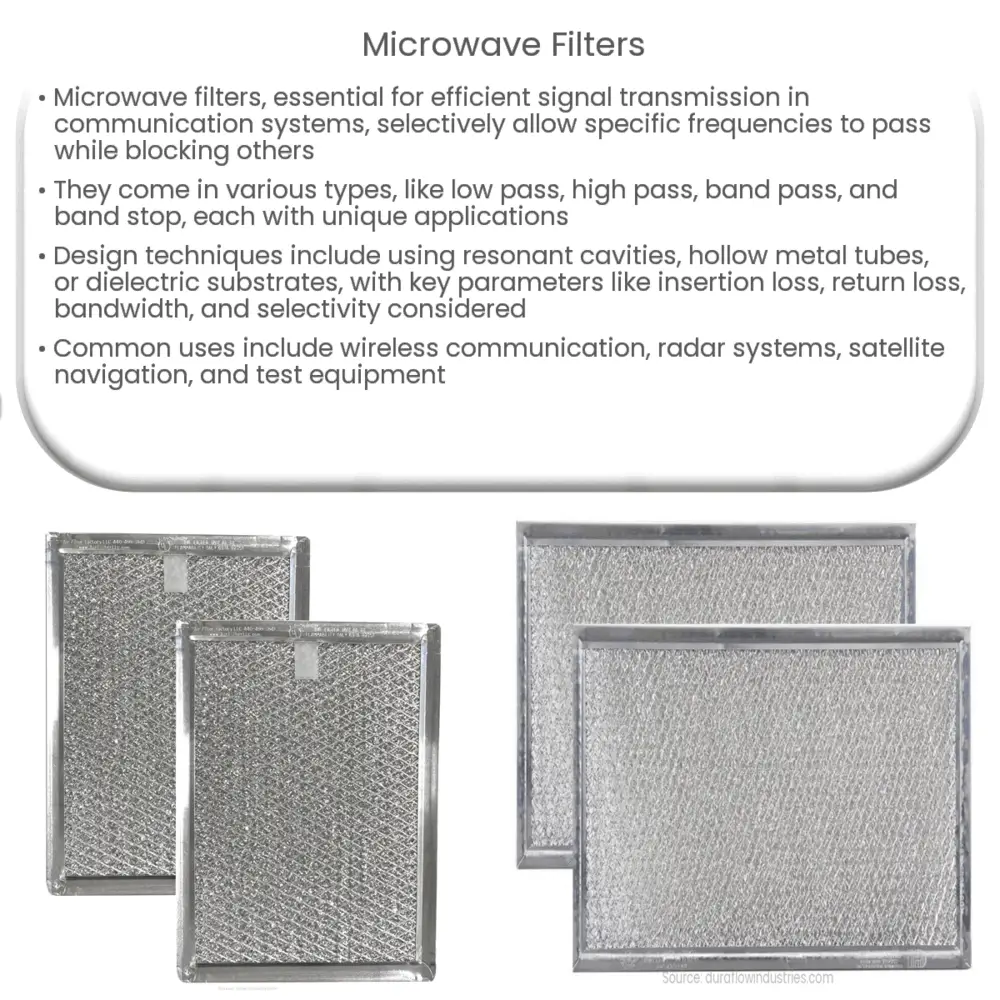Microwave filters selectively allow specific frequencies to pass, enabling efficient signal transmission in communication systems.

Microwave Filters: An Essential Component in Modern Communication Systems
Introduction
Microwave filters are crucial components in modern communication systems, enabling the efficient transmission and reception of signals in various applications. These components play a vital role in selecting desired frequency bands while rejecting undesired ones, making them indispensable in wireless communication, radar systems, and satellite technology. In this article, we will explore the fundamentals of microwave filters, their types, and their essential applications.
What are Microwave Filters?
Microwave filters are devices that selectively allow specific frequency components of a signal to pass through while attenuating or blocking others. They are used to suppress noise, eliminate interference, and isolate desired signals in communication systems. Microwave filters operate in the frequency range of 300 MHz to 300 GHz, which is commonly referred to as the microwave region of the electromagnetic spectrum.
Types of Microwave Filters
There are several types of microwave filters, each with its unique characteristics and applications. Some of the most commonly used microwave filters are:
- Low Pass Filters: These filters allow signals with frequencies below a specified cutoff frequency to pass through while attenuating signals with higher frequencies. They are commonly used to suppress high-frequency noise in communication systems.
- High Pass Filters: In contrast to low pass filters, high pass filters allow signals with frequencies above a specified cutoff frequency to pass through while attenuating lower-frequency signals. They are used to eliminate low-frequency interference and noise in communication systems.
- Band Pass Filters: Band pass filters are designed to allow a specific range of frequencies to pass through while attenuating signals outside this range. These filters are widely used in wireless communication systems for channel selection and frequency-division multiplexing (FDM).
- Band Stop Filters: Also known as notch filters, these filters block a specific range of frequencies while allowing signals outside this range to pass through. They are used to eliminate interference and unwanted signals in communication systems.
Design Techniques and Technologies
Microwave filter design is a complex process that requires a deep understanding of the electromagnetic behavior of materials and structures at high frequencies. Several design techniques and technologies are employed to create high-performance microwave filters, including:
- Cavity Filters: These filters utilize resonant cavities, which are hollow metallic structures designed to resonate at specific frequencies. Cavity filters are known for their high selectivity, low insertion loss, and excellent power handling capabilities.
- Waveguide Filters: Waveguide filters are constructed using hollow metal tubes, which guide electromagnetic waves along their length. These filters offer low insertion loss, high power handling, and good temperature stability.
- Planar Filters: Planar filters are fabricated using microstrip, stripline, or coplanar waveguide technologies on a dielectric substrate. These filters are compact, lightweight, and suitable for integration into printed circuit boards (PCBs) and monolithic microwave integrated circuits (MMICs).
Filter Design Parameters
Several design parameters are considered when developing microwave filters to ensure optimal performance. Some of the key parameters include:
- Insertion Loss: This parameter represents the amount of signal power lost when the signal passes through the filter. A lower insertion loss indicates better filter performance.
- Return Loss: Return loss measures the amount of reflected signal power at the input of the filter. A high return loss value indicates better impedance matching and less signal reflection, resulting in improved filter performance.
- Bandwidth: Bandwidth refers to the range of frequencies over which the filter allows signals to pass with minimal attenuation. It is a critical parameter for communication systems, as it directly impacts the system’s data rate and channel capacity.
- Selectivity: Selectivity measures the filter’s ability to discriminate between desired and undesired frequency components. Higher selectivity enables the filter to effectively isolate the desired signals from interference and noise.
Applications of Microwave Filters
Microwave filters find numerous applications in various domains due to their frequency-selective properties. Some of the most common applications include:
- Wireless Communication: In wireless communication systems, microwave filters are used for channel selection, frequency-division multiplexing, and suppressing interference from adjacent channels.
- Radar Systems: Filters are employed in radar systems for target detection, clutter rejection, and signal processing, ensuring accurate target identification and tracking.
- Global Navigation Satellite Systems (GNSS): Microwave filters are utilized in GNSS receivers to filter out unwanted signals and mitigate interference, allowing for accurate positioning and navigation.
- Test and Measurement Equipment: Microwave filters are essential components of various test and measurement equipment, such as spectrum analyzers and network analyzers, which are used for signal analysis and characterization in the microwave frequency range.
Conclusion
Microwave filters are indispensable components in modern communication systems, playing a vital role in signal processing, noise suppression, and interference mitigation. With the continuous advancement of wireless communication technologies and the increasing demand for higher data rates and broader frequency coverage, the development of high-performance microwave filters remains a critical area of research and innovation. As these technologies continue to evolve, microwave filters will undoubtedly play a significant role in shaping the future of communication systems and enabling seamless connectivity across the globe.

